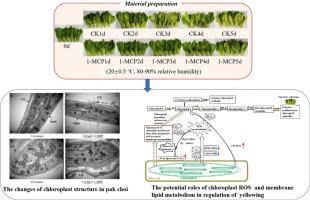当前位置:
X-MOL 学术
›
Sci. Hortic.
›
论文详情
Our official English website, www.x-mol.net, welcomes your
feedback! (Note: you will need to create a separate account there.)
Postharvest 1-methylcyclopropene application delays leaf yellowing of pak choi (Brassica rapa subsp. chinensis) by improving chloroplast antioxidant capacity and maintaining chloroplast structural integrity during storage at 20 °C
Scientia Horticulturae ( IF 3.9 ) Pub Date : 2020-08-01 , DOI: 10.1016/j.scienta.2020.109466 Liuli Song , Ruxin Yi , Haibo Luo , Li Jiang , Shimin Gu , Zhifang Yu
Scientia Horticulturae ( IF 3.9 ) Pub Date : 2020-08-01 , DOI: 10.1016/j.scienta.2020.109466 Liuli Song , Ruxin Yi , Haibo Luo , Li Jiang , Shimin Gu , Zhifang Yu

|
Abstract The aim of this study was to uncover the regulatory mechanism underlying the leaf yellowing of pak choi after 1-methylcyclopropene (1-MCP) treatment at (20 ± 0.5) °C. The ultrastructural, physiological and biochemical metabolism changes of the chloroplast in pak choi were investigated. Chlorophyll degradation was effectively alleviated by 1-MCP treatment, and the market life of pak choi was extended by 2 days compared with that of control. Electron microscopy confirmed that the chloroplast breakdown was reduced by 1-MCP. This treatment not only preserved the high activities of chloroplast antioxidant enzymes (superoxide dismutase SOD and ascorbic peroxidase APX) and non-enzymatic antioxidants (ascorbate-glutathione (AsA-GSH)) for scavenging reactive oxygen species (ROS) (superoxide anion O2·− and hydrogen peroxide H2O2), but also decreased the chloroplast chlorophyll-degrading peroxidase (Chl-POX) activity, thus retarding chlorophyll degradation in the peroxidase-H2O2 system. Abundant O2·- and H2O2 may function as major toxic molecules to enhance the activities of chloroplast phospholipase (PLD), lipoxygenase (LOX) and lipase. The loss of the chloroplast structural integrity and function caused by the high activities of PLD, lipase and LOX aggravated the enzymatic degradation of chlorophyll in pak choi, which was rescued by using 1-MCP that retarded the degradation of the chloroplast membrane, as well as maintained high unsaturated fatty acid levels and low malondialdehyde (MDA) level. In conclusion, 1-MCP fumigation may augment the chloroplast antioxidant capacity for scavenging ROS (O2·- and H2O2), which attenuated the activities of chloroplast PLD, lipase and LOX, inhibited the degradation of the chloroplast membrane and kept the membrane integrity and normal function, ultimately relieving the yellowing of pak choi.
中文翻译:

采后施用 1-甲基环丙烯通过提高叶绿体抗氧化能力和在 20°C 储存期间保持叶绿体结构完整性来延迟白菜(Brassica rapa subsp. chinensis)叶片变黄
摘要 本研究的目的是揭示在 (20 ± 0.5) °C 下 1-甲基环丙烯 (1-MCP) 处理后小白菜叶片变黄的调控机制。研究了白菜叶绿体的超微结构、生理生化代谢变化。1-MCP处理有效缓解了叶绿素的降解,与对照相比,白菜的上市寿命延长了2天。电子显微镜证实 1-MCP 减少了叶绿体分解。这种处理不仅保留了叶绿体抗氧化酶(超氧化物歧化酶SOD和抗坏血酸过氧化物酶APX)和非酶抗氧化剂(抗坏血酸谷胱甘肽(AsA-GSH))清除活性氧(ROS)(超氧阴离子O2·-)的高活性和过氧化氢 H2O2),但也降低了叶绿体叶绿素降解过氧化物酶 (Chl-POX) 的活性,从而延缓了过氧化物酶-H2O2 系统中叶绿素的降解。丰富的O2·-和H2O2可能是主要的毒性分子,可增强叶绿体磷脂酶(PLD)、脂氧合酶(LOX)和脂肪酶的活性。PLD、脂肪酶和 LOX 的高活性导致叶绿体结构完整性和功能的丧失加剧了小白菜中叶绿素的酶促降解,通过使用 1-MCP 阻止叶绿体膜的降解,以及维持高不饱和脂肪酸水平和低丙二醛 (MDA) 水平。总之,1-MCP熏蒸可以增强叶绿体清除ROS(O2·-和H2O2)的抗氧化能力,从而减弱叶绿体PLD的活性,
更新日期:2020-08-01
中文翻译:

采后施用 1-甲基环丙烯通过提高叶绿体抗氧化能力和在 20°C 储存期间保持叶绿体结构完整性来延迟白菜(Brassica rapa subsp. chinensis)叶片变黄
摘要 本研究的目的是揭示在 (20 ± 0.5) °C 下 1-甲基环丙烯 (1-MCP) 处理后小白菜叶片变黄的调控机制。研究了白菜叶绿体的超微结构、生理生化代谢变化。1-MCP处理有效缓解了叶绿素的降解,与对照相比,白菜的上市寿命延长了2天。电子显微镜证实 1-MCP 减少了叶绿体分解。这种处理不仅保留了叶绿体抗氧化酶(超氧化物歧化酶SOD和抗坏血酸过氧化物酶APX)和非酶抗氧化剂(抗坏血酸谷胱甘肽(AsA-GSH))清除活性氧(ROS)(超氧阴离子O2·-)的高活性和过氧化氢 H2O2),但也降低了叶绿体叶绿素降解过氧化物酶 (Chl-POX) 的活性,从而延缓了过氧化物酶-H2O2 系统中叶绿素的降解。丰富的O2·-和H2O2可能是主要的毒性分子,可增强叶绿体磷脂酶(PLD)、脂氧合酶(LOX)和脂肪酶的活性。PLD、脂肪酶和 LOX 的高活性导致叶绿体结构完整性和功能的丧失加剧了小白菜中叶绿素的酶促降解,通过使用 1-MCP 阻止叶绿体膜的降解,以及维持高不饱和脂肪酸水平和低丙二醛 (MDA) 水平。总之,1-MCP熏蒸可以增强叶绿体清除ROS(O2·-和H2O2)的抗氧化能力,从而减弱叶绿体PLD的活性,











































 京公网安备 11010802027423号
京公网安备 11010802027423号